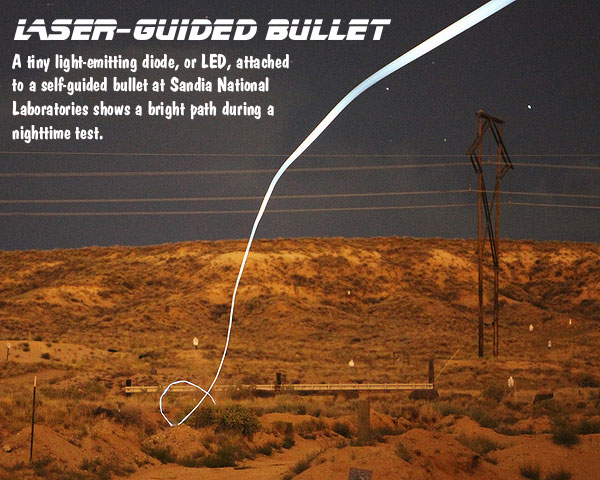Sandia Labs Develops Laser-Guided Bullet — Amazing Technology
Two Sandia National Laboratories engineers, both hunters, have developed a patented design for a laser-guided bullet. The 4″-long laser-guided projectile has made hits at ranges up to 2000 meters. No this is NOT an April Fools’ joke. The projectile shoots from a smooth-bore rifle and uses small, movable fins to adjust its trajectory. The fins are controlled by micro-sized actuators in response to signals from a tiny, onboard laser-sensor. Plastic sabots provide a gas seal and protect the delicate fins while the projectile is in the firearm’s barrel.
Click Here for Video News Report on Sandia-developed Guided Bullet
Sandia researchers Red Jones and Brian Kast (and colleagues) have invented a dart-like, self-guided bullet for small-caliber, smooth-bore firearms that could hit laser-designated targets at distances of more than a mile. “We have a very promising technology to guide small projectiles that could be fully developed inexpensively and rapidly,” Jones said. Researchers have had initial success testing the design in computer simulations and in field tests of prototypes, built from commercially available parts, Jones said. While engineering issues remain, “we’re confident in our science base and we’re confident the engineering-technology base is there to solve the problems,” he said.

Sandia’s design for the four-inch-long bullet includes an optical sensor in the nose to detect a laser beam on a target. The sensor sends information to guidance and control electronics that use an algorithm in an eight-bit central processing unit to command electromagnetic actuators. These actuators steer tiny fins that guide the bullet to the target.
Fin-Stabilization — Like on a Guided Missile
The guided projectile is shot from smooth bore barrel with no rifling. While conventional bullets are spin-stabilized, Scandia’s guided bullet doesn’t spin in flight. To enable the guided bullet to adjust its trajectory toward a target and to simplify the design, the spin had to go, Jones said. As on most guided missiles, fins both stabilize and steer the projectile. But on this projectile, the fins are tiny — just a few millimeters tall.
The bullet flies straight due to its aerodynamically stable design, which consists of a center of gravity that sits forward in the projectile and tiny fins that enable it to fly without spin, just as a dart does, he said. The four-inch-long bullet has actuators that steer tiny fins that guide it to its target.
Projectile Flies at 2400 fps — More Speed Is Possible
Testing has shown the electromagnetic actuator performs well and the bullet can reach speeds of 2,400 feet per second, or Mach 2.1, using commercially available gunpowder. The researchers are confident it could reach standard military speeds using customized gunpowder.

Sub-MOA Accuracy at 1000m — No Matter What the Wind Does
Computer aerodynamic modeling shows the design would result in dramatic improvements in accuracy, Jones said. Computer simulations showed an unguided bullet under real-world conditions could miss a target more than a half mile away (1,000 meters away) by 9.8 yards (9 meters), but a guided bullet would get within 8 inches (0.2 meters), according to the patent.
The prototype does not require a device found in guided missiles called an inertial measuring unit, which would have added substantially to its cost. Instead, the researchers found that the bullet’s relatively small size when compared to guided missiles “is helping us all around. It’s kind of a fortuitous thing that none of us saw when we started,” Jones said.
As the bullet flies through the air, it pitches and yaws at a set rate based on its mass and size. In larger guided missiles, the rate of flight-path corrections is relatively slow, so each correction needs to be very precise because fewer corrections are possible during flight. But “the natural body frequency of this bullet is about 30 hertz, so we can make corrections 30 times per second. That means we can over-correct, so we don’t have to be as precise each time,” Jones said.
Projectile Becomes More Stable After Launch
Researchers also filmed high-speed video of the bullet radically pitching as it exited the barrel. The bullet pitches less as it flies down range, a phenomenon known to long-range firearms experts as “going to sleep.” Because the bullet’s motions settle the longer it is in flight, accuracy improves at longer ranges, Jones said. “Nobody had ever seen that, but we’ve got high-speed video photography that shows that it’s true,” he said. (See below)
Similar Posts:
- Air Rifle Slugs vs. Pellets — Optimizing Barrel Twist Rate
- How Rifle Ammunition Works — Amazing CGI Animation
- Gun TECH: DARPA Unveils Guided EXACTO .50 Caliber Projectiles
- Guided .50 Caliber Projectile — DARPA’s Steerable Bullet
- Measure Groups Precisely with Neil Jones Tool
Tags: Arrow, bullet, Laser, Projectile, Sandia Laboratory, Tracking


















Great technology – but somebody’s got to “paint” the target for it home in on, so why not just give the guy with the Laser designator a rifle?
Reminds me that during the race to space, we spent months and lots of $$ designing and making a pen that would write in zero-G.
The Russians just used a pencil.
Not quite the way the space pen development went…
http://twowheeledmadwoman.blogspot.com/2011/12/spaaaaace-pen.html
At the present stage it smells of vaporware. I think they have done a lot more calculating than actual shooting. I look forward to seeing some groups shot at 2000 meters, along with energy-delivered-on-target numbers.
Merely dreamware at this point..
Rumor is Shiraz has bought the company and will be shooting these bullets in F-Open at future matches.